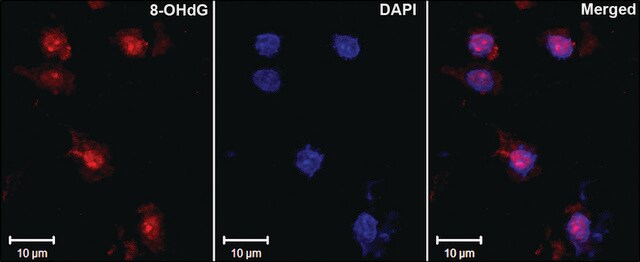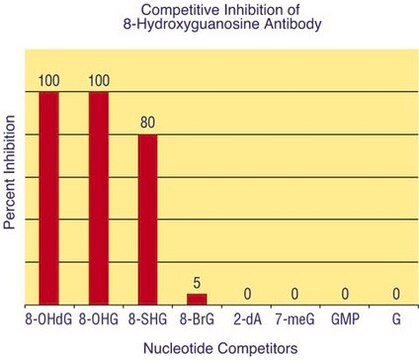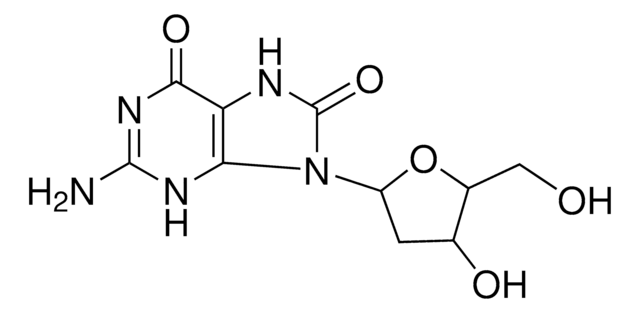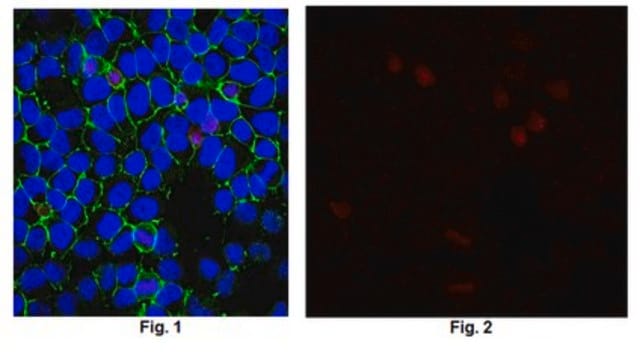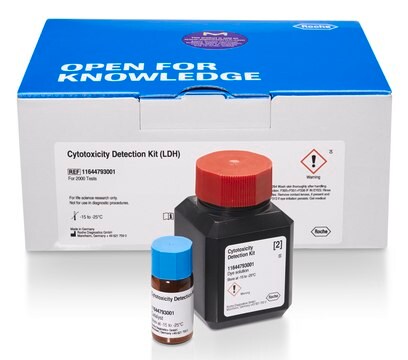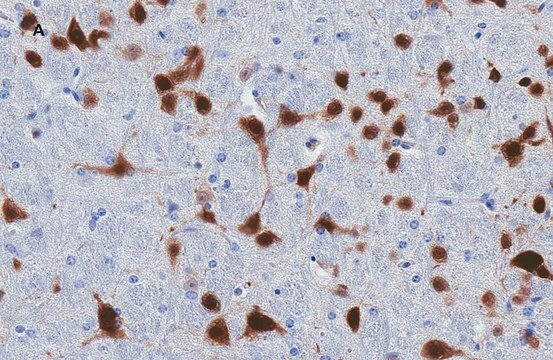MAB3560
Anti-8-Oxoguanine Antibody, clone 483.15
ascites fluid, clone 483.15, Chemicon®
Sinonimo/i:
8-oxoG
About This Item
Prodotti consigliati
Origine biologica
mouse
Livello qualitativo
Forma dell’anticorpo
ascites fluid
Tipo di anticorpo
primary antibodies
Clone
483.15, monoclonal
Reattività contro le specie
monkey, human, primate
Reattività contro le specie (prevista in base all’omologia)
mouse, rat
Produttore/marchio commerciale
Chemicon®
tecniche
ChIP: suitable
ELISA: suitable
immunocytochemistry: suitable
Isotipo
IgM
Condizioni di spedizione
dry ice
modifica post-traduzionali bersaglio
unmodified
Informazioni sul gene
human ... OGG1(4968)
Descrizione generale
Specificità
Immunogeno
Applicazioni
On HeLa and Cos7 cells fixed with paraformaldehyde. 8-oxoguanine has been localized to the nucleus in nutrient-deprived cells.
ELISA:
Cell grown in slides were extracted twice for 30 sec with cold 560nM NaCl;0.1% (v/v) Triton X-100;0.02% (w/v) SDS;10mM phosphate buffer pH 7.4 and fixed with freshly prepared 4% PFA for 5-20 minutes at room temperature. {Conlon, KA et al (2000) J. Histotechnology 23(1):37-44}. Typical staining shows that nuclei from extracted cells have define periphery and areas of condensed chromatin. Clone 483.15 staining showed specific but faint nuclear fluorescence staining in cells incubated in supplemented DMEM, but in cells incubated in nutrient-free defined solt solution (NFDSS) {1.8mM calcium chloride, 110mM NaCl, 44mM sodium biocarbonate, pH 7.5} showed strong nuclear fluorescence staining that appeared punctate and gernerally distributed. Fluorescence staining disappears to background levels in cells incubated in nutrient medias even after initial NFDSS treatments {Conlon et al}.
A previous lot of this antibody was used in an ELISA assay.
Optimal working dilutions must be determined by end user.
Qualità
Immunocytochemistry:
Confocal fluorescent analysis of NIH/3T3 cells using anti-8-oxoguanine mouse monoclonal antibody.
Stato fisico
Stoccaggio e stabilità
Handling Recommendations: Upon receipt, and prior to removing the cap, centrifuge the vial and gently mix the solution. Aliquot into microcentrifuge tubes and store at -20°C. Avoid repeated freeze/thaw cycles, which may damage IgM and affect product performance.
Risultati analitici
Nutrient starved HeLa or Cos7 cells
Altre note
Note legali
Non trovi il prodotto giusto?
Prova il nostro Motore di ricerca dei prodotti.
Codice della classe di stoccaggio
10 - Combustible liquids
Classe di pericolosità dell'acqua (WGK)
nwg
Punto d’infiammabilità (°F)
Not applicable
Punto d’infiammabilità (°C)
Not applicable
Certificati d'analisi (COA)
Cerca il Certificati d'analisi (COA) digitando il numero di lotto/batch corrispondente. I numeri di lotto o di batch sono stampati sull'etichetta dei prodotti dopo la parola ‘Lotto’ o ‘Batch’.
Possiedi già questo prodotto?
I documenti relativi ai prodotti acquistati recentemente sono disponibili nell’Archivio dei documenti.
Il team dei nostri ricercatori vanta grande esperienza in tutte le aree della ricerca quali Life Science, scienza dei materiali, sintesi chimica, cromatografia, discipline analitiche, ecc..
Contatta l'Assistenza Tecnica.